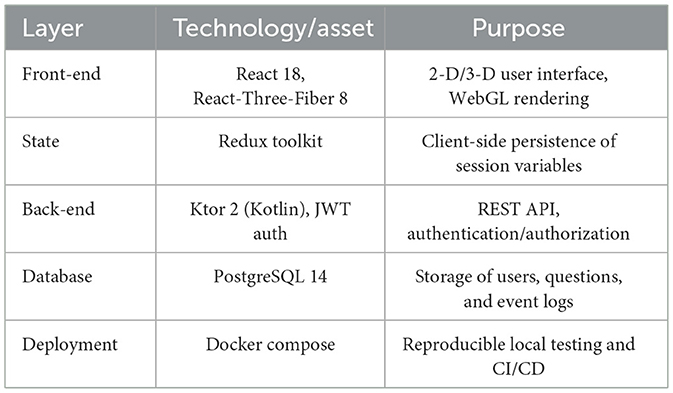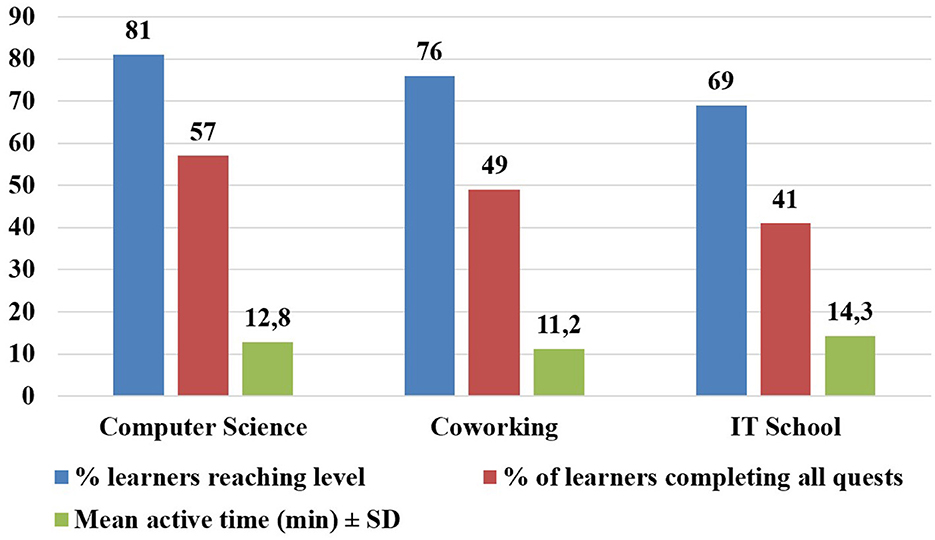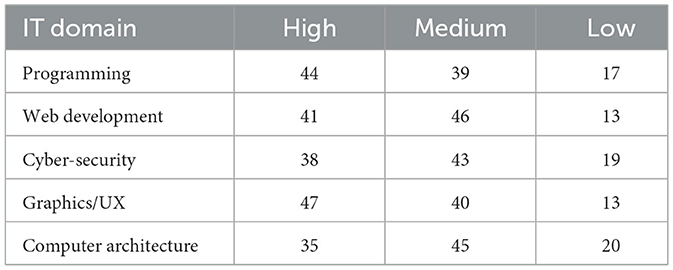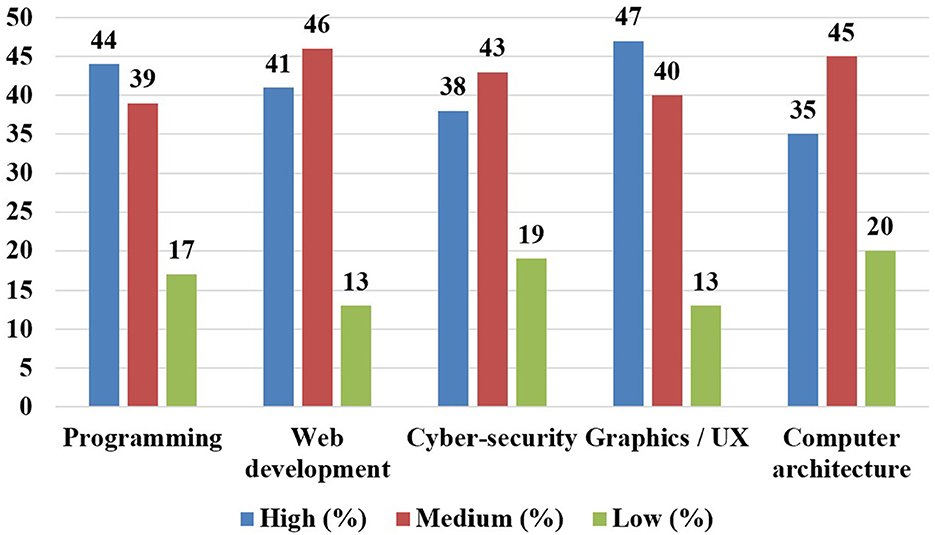- 1Faculty of Computer Science, Toraighyrov University, Pavlodar, Kazakhstan
- 2Committee of Higher and Postgraduate Education of the Ministry of Science and Higher Education of the Republic of Kazakhstan, Astana, Kazakhstan
Digitization is reshaping Kazakhstan's labor market; yet school-based career guidance still relies on paper inventories that fail to uncover students' latent interests in emerging technology domains. We developed Game for Career Guidance (GCG). This bilingual (web-based) platform combines gamification with hidden assessment to profile upper-secondary pupils' competences in programming, cyber-security, web development, graphics/UX, and computer architecture. A 6-week field trial involved 1,865 grade-11 learners from 45 state schools in Pavlodar. Gameplay logs captured unobtrusive event traces, which were converted to Rasch-weighted mastery scores; post-session surveys measured motivation, usability, and state anxiety. Eighty-three percent of participants reached at least medium mastery in three or more domains, and 92 % completed the tutorial and entered formal play. Mean Intrinsic Motivation Inventory (5.6/7) and System Usability Scale (SUS) (76/100) scores indicated high engagement and usability, while state-anxiety remained low (1.9/5). Hierarchical models showed that flow significantly predicted mastery after controlling for prior GPA. Qualitative feedback echoed these findings and emphasized the value of authentic micro-tasks and a seamless Kazakh–Russian interface. The results demonstrate that gamified hidden assessment can motivate learners and deliver fine-grained evidence for counselors without additional testing time. The open-source architecture offers a readily scalable blueprint for modernizing career guidance in other rapidly digitizing educational systems.
1 Introduction
Rapid technological change, automation, and the data-driven economy are reconfiguring the work structure globally. Analysts report that tasks once performed through routine manual or clerical effort are displaced by roles that demand digital literacy, problem-solving, and agile learning (Hu et al., 2024; Li, 2024). Kazakhstan is experiencing the same pressures. Government white papers highlight digitalization as a national priority and call for education systems that can “produce specialists for an economy in permanent flux” (Government of the Republic of Kazakhstan, 2024). These labor-market shifts render school-based career guidance more consequential than ever. International reviews link high-quality guidance to smoother school-to-work transitions and more resilient career trajectories (OECD, 2021; Ntholeng, 2024). Additionally, psychological theories of optimal experience, particularly Flow Theory introduced by (Csíkszentmihályi 1990), underline the importance of deep engagement and intrinsic motivation in educational environments.
1.1 Gamification and hidden assessment as complementary solutions
Gamification is the strategic use of game mechanics such as points, levels, and narrative frames in non-game contexts. It has been widely shown to boost learner motivation and persistence (Muntean, 2011; Zeybek and Saygi, 2024). Hidden assessment integrates formative measurement into gameplay so that students demonstrate skills organically, free from the anxiety that formal testing can induce (Caponetto et al., 2014; Gee, 2003). Local and international evidence suggests that a well-designed synthesis of these approaches can reveal nuanced preference profiles while simultaneously cultivating transversal skills such as collaboration and creative problem-solving (Valtonen et al., 2021; Oliveira et al., 2023). Notably, the unobtrusive nature of hidden assessment aligns with contemporary principles of assessment for learning, enabling rich diagnostic feedback without interrupting flow (Tai et al., 2018).
1.2 Research gap
Despite promising international results, few platforms embed gamification and hidden assessment in the Central Asian secondary-school context. Existing Kazakh initiatives concentrate on overt testing or extracurricular coding camps, leaving a lacuna for scalable, curriculum-linked solutions that can unobtrusively map students' evolving interest–skill constellations in technology-heavy fields such as computer science, cybersecurity, and digital entrepreneurship (Obasi and Benson, 2025; Liubarets et al., 2024).
1.3 Study contributions
To address this gap, we developed the Game for Career Guidance (GCG), a web-based platform that couples gamified 3-D exploration with backend analytics to perform a hidden assessment of senior-secondary students' ICT competences. Building on prior evidence, game-based design can surface latent interests and higher-order skills (Valtonen et al., 2021). The paper reports on the platform's conceptual rationale, technical architecture, and first-round field evaluation in Kazakh schools. Specifically, we ask:
• To what extent can a gamified hidden assessment environment accurately identify students' underlying interests and foundational competencies in digital technology domains?
• How do students view motivation, stress, and usability in the GCG environment?
• What design principles are emerging for future career-guidance tools in rapidly digitizing economies?
2 Literature review
2.1 Persistent shortcomings in school-based career guidance
High-school learner's worldwide struggle to make informed programme and career choices because conventional pencil-and-paper inventories often surface only explicit preferences and are insensitive to contextual or affective factors (Eseadi, 2024; Nehass et al., 2025; Dick and Rallis, 1991). Guidance practice remains similarly test-centric in Kazakhstan despite policy calls for approaches that capture the competencies demanded by a digitizing labor market (Government of the Republic of Kazakhstan, 2024; OECD, 2021).
2.2 Gamification as a motivational architecture
Gamification, as conceptualized by (Deterding et al. 2011), embeds game mechanics into non-game contexts to stimulate engagement. Meta-analyses confirm positive effects on persistence, time on task, and perceived autonomy in educational settings (Oliveira et al., 2023; Zeybek and Saygi, 2024). Beyond raw motivation, gamified tasks encourage higher-order capabilities such as problem-solving, collaboration, and leadership by situating learners in goal-directed, feedback-rich micro-worlds (Deterding et al., 2011; Anderson and Rainie, 2017). The integration of flow elements in gamification—such as clear goals, immediate feedback, and balanced challenge levels—is critical for fostering sustained engagement and a sense of enjoyment (Csíkszentmihályi, 1990).
2.3 Hidden assessment for authentic evidence
Hidden assessment, sometimes called stealth assessment (Shute, 2009), embeds diagnostic metrics inside gameplay so learners demonstrate competencies organically rather than through high-stakes testing. Studies show that this approach reduces test anxiety, yields fine-grained performance traces, and supports formative feedback loops (Tai et al., 2018; Gerli et al., 2022). By logging unobtrusive interactions, systems can infer constructs such as persistence or creative reasoning with greater ecological validity than traditional surveys.
2.4 Complementarity of gamification and hidden assessment
Gamification supplies the motivational scaffolding, while hidden assessment supplies the measurement substrate. When combined, students remain immersed, yet the platform continuously maps their emerging interest–skill profile. Empirical work reports that learners perceive such environments as low-pressure and enjoyable, leading to richer data for counselors (Muntean, 2011; Gee, 2003; Caponetto et al., 2014). Adaptive game engines can further personalize quests so that each learner confronts tasks aligned with their evolving zone of proximal development, a design that enhances accuracy and perceived fairness (Oliveira et al., 2023).
2.5 Evidence gaps in the central-Asian context
While the international literature on gamified hidden assessment is expanding, few studies focus on Central Asia. Existing Kazakh initiatives emphasize overt testing or short-term coding bootcamps and rarely utilize modern web technologies capable of delivering 3-D, bilingual experiences on standard school hardware (Obasi and Benson, 2025; Liubarets et al., 2024). Consequently, educators lack scalable tools to unobtrusively diagnose students' interest in emerging digital disciplines such as cybersecurity or data science.
2.6 Positioning the present study
Against this backdrop, the Game for Career Guidance (GCG) project advances the field in three ways. First, it operationalizes gamification and hidden assessment within a fully web-based, React + Three-Fiber architecture that runs in Kazakh or Russian without additional plugins. Second, it aligns quests with nationally recognized digital-skills frameworks, connecting evidence to actionable curricular advice. Third, it provides the first large-scale empirical dataset of 1,865 upper-secondary students across 45 schools on how Kazakh learners interact with a stealth-assessed, gamified guidance tool. These contributions respond directly to the lacuna identified above and inform local policy and the broader literature on career-guidance innovation.
3 Methods
3.1 Research design
The study utilized an explanatory-sequential mixed-methods design (Creswell, 2014). First, the platform's hidden-assessment engine analyzed the quantitative event traces that had been captured. Qualitative follow-ups included open-ended survey items and focus group discussions with teachers from participating schools to interpret unexpected patterns.
3.2 Participants and setting
Data were collected in May–June 2024 from 1,865 grade-11 students (final-year, mean age = 17.2 years) enrolled in 45 state schools in Pavlodar city, Kazakhstan. Participation was voluntary. Schools distributed parental consent forms in Kazakh or Russian. The university's ethics committee (protocol TU-EDU-2024-05) approved all procedures.
3.3 Intervention: the game for career guidance (GCG) platform
The GCG system follows five-layer web architecture (Table 1). At the front end, React 18 combined with React-Three-Fiber 8 renders a seamless 2-D/3-D interface directly in WebGL-enabled browsers. A state-management layer based on Redux Toolkit holds session variables—current level, language choice, badge status—so learners can refresh or switch devices without losing progress. The back end is a Ktor 2 (Kotlin) REST service protected by JWT authentication; it brokers every client request, checks permissions, and returns JSON payloads. Below that, a PostgreSQL 14 database stores persistent entities (users, quest items, event logs) and exposes materialized views that aggregate hidden-assessment traces in near real time. Finally, the whole stack is wrapped in a Docker-Compose deployment that guarantees reproducible local testing and continuous integration/delivery.
3.4 Game flow and content
After a welcome screen, learners sign in or register and access Menu 1 (About Us, Profile) or Menu 2 (Achievements, Level Selection). Three thematic 3-D levels are offered: Computer Science, Coworking, and IT School. Each level includes quests that reflect authentic IT tasks (e.g., debugging code, configuring network topologies) and culminate in assembling a functional artifact (workstation, server rack, and network). Achieved objectives unlock badges. An in-game leaderboard showcases each student's rank.
3.5 Hidden assessment instrumentation
During play, the client asynchronously transmits encrypted JSON packets to the server containing:
• event_type (task_start, option_click, code_submit, hint_request, etc.)
• time stamp (Unix ms)
• task_id, level_id
• payload (e.g., code diff, multiple-choice option, numeric answer)
On the server, SQL views aggregate correct and incorrect responses by users and difficulty, using the query template in Listing 1.
3.6 Outcome measures
Learners' performance and perceptions were captured using four complementary instruments (Table 2). First, an interest–skill profile was computed as the percentage of correct in-game actions in each IT domain, weighted by Rasch-calibrated item difficulty to yield person-ability logits. Second, motivation and flow were assessed with the Intrinsic Motivation Inventory on a seven-point Likert scale; the scale demonstrated excellent internal consistency in our sample (Cronbach's α = 0.91).
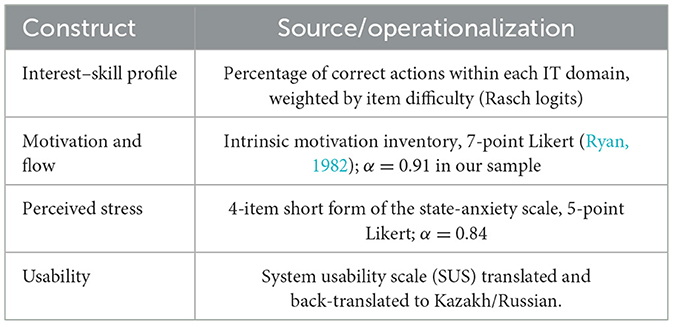
Table 2. Operational definitions, sources, and reliability of the four outcome measures employed in the study.
Third, perceived stress was assessed immediately after play using the four-item short form of the State-Anxiety Scale (five-point Likert, α = 0.84). Fourth, overall usability was evaluated with the System Usability Scale (SUS), which had been independently translated and back-translated into Kazakh and Russian to ensure semantic fidelity. Throughout the session, learners could toggle the interface language (Kazakh ↔ Russian) via a persistent switch in the lower-left corner of the screen, allowing them to complete all instruments in their preferred language.
3.7 Procedure
1. Onboarding (10 min): Teachers projected a short tutorial video and distributed consent forms.
2. Gameplay session (35 min): Students worked individually in school computer labs (Chrome v123+, 8 Mbps connection).
3. Post-game survey (10 min): Surveys were embedded in the same web app; completing them unlocked a “Reflector” badge.
4. Focus groups (optional, 20 min): A single voluntary focus group discussion was held over Zoom with one teacher representative to explore implementation issues.
3.8 Data analysis
Quantitative logs were exported as CSV files and cleaned using Python 3.11 (pandas 2.2). We calculated domain-specific mastery scores and ran hierarchical linear models to predict mastery based on prior grades, gameplay duration, and school clustering effects. Teacher focus group transcripts were analyzed thematically, supplementing student open-ended responses; inter-rater reliability was κ = 0.79. Triangulation linked emerging themes to quantitative outliers.
3.9 Ethical considerations
The study involving human participants was reviewed and approved by the Toraighyrov University Human Research Ethics Committee (protocol TU-EDU-2024-05). Written informed consent was obtained from all participating students and their parents or legal guardians, under Article 149 of the Code of the Republic of Kazakhstan “On People's Health and the Healthcare System.” Participation was voluntary, data were pseudonymized before export, and all procedures adhered to the latest revision of the Declaration of Helsinki.
4 Results
4.1 Reach and platform uptake
During the 6-week roll-out, 1,865 grade-11 learners from 45 secondary schools in Pavlodar created an account and launched at least one level of the Game for Career Guidance platform. Server logs indicate that 92% of registered users (n = 1,718) completed the tutorial and entered formal gameplay.
4.2 Level-completion patterns
A level is considered “unlocked” after a learner solves five thematically linked quests. Across the sample, 81% of pupils opened the Computer Science level, and 57% finished every quest, spending an average of 12.8 ± 4.6 min on active play. Uptake then tapered: 76% entered Coworking, while 49% completed it in 11.2 ± 3.9 min. Meanwhile, 69% reached IT School, and 41% completed it, investing the longest active time at 14.3 ± 5.1 min. A repeated-measures logistic model confirmed a significant linear decline in the odds of full completion across successive levels (β = −0.37, p < 0.001). Nevertheless, 58% of learners still completed at least two of the three locations. Table 3 and Figure 1 provide the full numeric breakdown.
4.3 Domain-specific mastery
Rasch-weighted scores were grouped into three criterion-referenced bands—High (≥ 0.5 logit), Medium (−0.5 to +0.49 logit), and Low (< −0.5 logit). The distribution reveals distinct strengths: 47% of learners achieved High mastery in Graphics/UX, 44% in Programming, 41% in Web Development, 38% in Cybersecurity, and 35% in Computer Architecture. Corresponding Medium proportions ranged from 39% to 46%, while Low mastery was limited to 13% to 20%, depending on the domain. Eighty-three percent of students reached at least Medium mastery in three or more domains, indicating that the hidden-assessment engine effectively uncovered multiple latent competencies. Detailed percentages are available in Table 4 and Figure 2.
4.4 Motivation, flow, and stress
Post-session surveys (response rate = 88%) showed a mean Intrinsic Motivation Inventory score of 5.6 ± 0.8 (7-point scale) and a System Usability Scale of 76.4 ± 9.2, placing GCG in the “good” range. State-anxiety values were low (M = 1.9 ± 0.7). Linear mixed models indicated that higher flow predicted greater domain mastery (β = 0.28, p < 0.01) after controlling for prior GPA.
4.5 Qualitative insights
Open-ended comments (n = 1,324) and 45 teacher focus groups focused on three themes:
• Authenticity: Learners appreciated quests “that feel like real IT tasks,” especially network setup challenges in the IT School.
• Competition vs. collaboration: Although the leaderboard (top 5 plus personal rank) motivated effort, some teachers requested optional cooperative modes to reduce comparison pressure.
• Language toggling: The Kazakh/Russian switcher received praise. However, several respondents suggested an English version to reflect university entrance expectations.
5 Discussion
5.1 Hidden assessment as a valid lens on latent interests (RQ 1)
The platform's difficulty-weighted Rasch scores showed that four out of five learners achieved at least medium mastery in three or more technology domains, a trend that closely mirrored previous self-report surveys conducted by the Pavlodar regional education office in 2023. Convergent patterns from two independent data sources reinforce the assertion that unobtrusive, in-game traces can reveal pupils' genuine interests and baseline competencies. This finding aligns with international experiments indicating that stealth metrics predict subsequent course choices more accurately than paper inventories (Tai et al., 2018; Gerli et al., 2022).
5.2 Motivation, flow, and low-test anxiety (RQ 2)
Mean Intrinsic Motivation Inventory and System Usability Scale scores fell within the “good–excellent” range, while state-anxiety remained low. These quantitative signals support qualitative comments that quests felt “like real IT work, not exams,” echoing meta-analytic evidence that gameful design promotes autonomy and reduces evaluative stress (Oliveira et al., 2023; Zeybek and Saygi, 2024). The positive coefficient linking flow to domain mastery (β = 0.28) also aligns with self-determination theory predictions that deep engagement facilitates sustained effort (Ryan and Deci, 2020).
5.3 Design principles for future career-guidance tools (RQ 3)
1. Authentic micro-tasks: Quests based on recognizable IT practices, such as configuring network topologies, generated the strongest engagement and supported the authenticity principle advanced by (Gee 2003).
2. Progressive disclosure of complexity: This indicates that the odds of completion decreased across levels. However, the majority of participants still finished in two out of three worlds. Therefore, a gradual increase in challenge appears optimal for mixed-ability groups.
3. Opt-in competitiveness: Some learners thrived on the leaderboard, while others favored collaboration, suggesting that competitive mechanics should be adjustable to accommodate diverse motivational profiles, a recommendation echoed by (Deterding et al. 2011).
4. Seamless bilingualism: The Kazakh/Russian switcher proved essential, and participants requested an English layer. Thus, a multilingual UI is a critical design element in trilingual systems.
5.4 Limitations
Several caveats temper these conclusions. First, the sample was geographically concentrated in Pavlodar; replication in rural and multi-ethnic regions is necessary for national generalizability. Second, the 6-week window does not eliminate novelty effects; longitudinal follow-up will clarify whether motivation persists. Third, mastery estimates may still carry measurement error because Rasch calibration used a single cohort; future iterations should pool data across cycles to stabilize item parameters. Fourth, the study used self-reported prior GPA as a covariate, introducing potential bias. Additionally, self-reporting bias may have influenced the validity of subjective responses, particularly regarding Intrinsic Motivation Inventory scores, State-Anxiety measures, and prior academic records. This form of bias is a common limitation in educational field trials and may affect the precision of the psychological constructs measured. Finally, although data were pseudonymized, any analytics platform must remain vigilant about privacy and algorithmic transparency.
5.5 Implications and future directions
For practice, findings justify integrating gamified hidden-assessment modules into the compulsory Grade 11 career guidance curriculum currently being revised by the Ministry of Education. Exportable mastery dashboards can help counselors tailor advice without adding testing time. For policy, the project demonstrates how modest hardware (WebGL-capable PCs) can host high-fidelity guidance tools, reducing urban-rural disparities highlighted in recent OECD reviews. For research, the open-source codebase and anonymized logs provide a rare, large-scale dataset for modeling the intersection of motivation, competency development, and career choice in emerging economies. Future studies should: (i) randomize exposure to isolate causal effects; (ii) test adaptive quest sequencing algorithms; and (iii) explore cross-domain transfer, for example, whether programming-level mastery predicts subsequent success in mathematics or physics.
6 Conclusion
This study demonstrates that a fully web-based, gamified platform built with React, React-Three-Fiber, and Ktor can unobtrusively diagnose upper-secondary learners' emerging digital-technology competencies while sustaining high motivation and minimal test anxiety. Across 1,865 grade-11 pupils in 45 Kazakh schools, gameplay logs produced difficulty-weighted mastery scores that converged with independent self-report data, supporting the validity of hidden assessment as a lens on latent interests. Learners rated the experience as engaging and usable, and qualitative feedback highlighted the value of authentic micro-tasks and seamless bilingual support.
Data availability statement
The original contributions presented in the study are included in the article/supplementary material, further inquiries can be directed to the corresponding author.
Ethics statement
The studies involving humans were approved by Ethical Committee of Toraighyrov University. The studies were conducted in accordance with the local legislation and institutional requirements. Written informed consent for participation in this study was provided by the participants' legal guardians/next of kin.
Author contributions
NT: Supervision, Writing – original draft, Project administration. GJ: Supervision, Funding acquisition, Writing – review & editing, Project administration. AT: Formal analysis, Writing – original draft, Visualization, Methodology, Validation. NO: Software, Project administration, Investigation, Writing – review & editing. SB: Resources, Funding acquisition, Methodology, Conceptualization, Writing – review & editing.
Funding
The author(s) declare that financial support was received for the research and/or publication of this article. This research has been funded by the Science Committee of the Ministry of Science and Higher Education of the Republic of Kazakhstan (Grant No. AP19677291 Development of a platform for stealth assessment of high school students' competencies through gamification for career guidance).
Conflict of interest
The authors declare that the research was conducted in the absence of any commercial or financial relationships that could be construed as a potential conflict of interest.
Generative AI statement
The author(s) declare that no Gen AI was used in the creation of this manuscript.
Publisher's note
All claims expressed in this article are solely those of the authors and do not necessarily represent those of their affiliated organizations, or those of the publisher, the editors and the reviewers. Any product that may be evaluated in this article, or claim that may be made by its manufacturer, is not guaranteed or endorsed by the publisher.
References
Anderson, J., and Rainie, L. (2017). The Future of Jobs and Jobs Training. Washington, DC: Pew Research Center.
Caponetto, I., Earp, J., and Ott, M. (2014). “Gamification and education: a literature review,” in Proceedings of eLearning and Software for Education (eLSE) 2014 (Bucharest: Academic Conferences and Publishing International Limited (ACPIL)), 123–130.
Creswell, J. W. (2014). Research Design: Qualitative, Quantitative, and Mixed-Methods Approaches, 4th Edn. Los Angeles: SAGE.
Deterding, S., Khaled, R., Nacke, L., and Dixon, D. (2011). Gamification: toward a definition', in CHI 2011 Gamification Workshop Proceedings (Vancouver, BC: ACM), 1–4.
Dick, T. P., and Rallis, S. F. (1991). ‘Factors and influences on high-school students' career choices. J. Res. Math. Educ. 22, 281–292. doi: 10.5951/jresematheduc.22.4.0281
Eseadi, C. (2024). Impacts and barriers associated with career transition among students with specific learning disabilities. J. Educ. Teach. 5:318. doi: 10.51454/jet.v5i1.318
Gee, J. P. (2003). What video games have to teach us about learning and literacy. Comput. Entertain. 1:20. doi: 10.1145/950566.950595
Gerli, P., Clement, J., Esposito, G., Mora, L., and Crutzen, N. (2022). The hidden power of emotions: how psychological factors influence skill development in smart-technology adoption. Technol. Forecast. Soc. Change 180:121721. doi: 10.1016/j.techfore.2022.121721
Government of the Republic of Kazakhstan (2024). Results of the year: modern trends in the education system—from inclusiveness to digitalization, Prime Minister's Office, Nur-Sultan, viewed 15 May 2025. Available online at: https://primeminister.kz/ru/news/reviews/itogi-goda-sovremennye-tendentsii-v-sisteme-obrazovaniya-ot-inklyuzivnosti-do-tsifrovizatsii-29532# (Accessed May 2, 2025).
Hu, Y., Pan, Y., Yu, M., and Chen, P. (2024). Navigating digital transformation and knowledge structures: insights for small and medium-sized enterprises. J. Knowl. Econ. 15, 16311–16344. doi: 10.1007/s13132-024-01754-x
Li, L. (2024). Reskilling and upskilling the future-ready workforce for industry 4.0 and beyond. Inf. Syst. Front. 26, 1697–1712. doi: 10.1007/s10796-022-10308-y
Liubarets, V., Kashyna, G., Kachan, Y., Brezetskyi, S., and Ostrovershenko, A. (2024). Adapting professional development to the digital-transformation of today's job market. Multidiscip. Sci. J. 6:e2024ss0713. doi: 10.31893/multiscience.2024ss0713
Muntean, C. I. (2011). “Raising engagement in e-learning through gamification,” in The 6th International Conference on Virtual Learning ICVL 2011 (Cluj-Napoca), 323–329.
Nehass, B., Ismaili, J., Merzaq, G., Kiouach, A., Bounaissat, A., and Zarhbouch, B. (2025). Psychometric characteristics of the decision-making ability scale among high-school students. Psychol. Sch. 62, 475–491. doi: 10.1002/pits.23334
Ntholeng, M. G. (2024). The effect of career guidance in secondary schools on skills development and sustained economic participation: meaningful employment. M.Com Thesis. University of Cape Town, South Africa.
Obasi, I. C., and Benson, C. (2025). The impact of digitalisation and ICT on the nature and organisation of work and the emerging challenges for occupational safety and health. Int. J. Environ. Res. Public Health 22:362. doi: 10.3390/ijerph22030362
Oliveira, W., Hamari, J., Shi, L., Toda, A. M., Rodrigues, L., Palomino, P. T., and Isotani, S. (2023). Tailored gamification in education: a literature review and future agenda. Educ. Inf. Technol. 28, 373–406. doi: 10.1007/s10639-022-11122-4
Ryan, R. M. (1982). Control and information in the intrapersonal domain: an extension of cognitive evaluation theory. J. Personal. Soc. Psychol. 43, 450–461. doi: 10.1037//0022-3514.43.3.450
Ryan, R. M., and Deci, E. L. (2020). Intrinsic motivation and self-determination theory in human behaviour: reappraisal and review. Contemp. Educ. Psychol. 61:101860. doi: 10.1016/j.cedpsych.2020.101860
Shute, V. J. (2009). Stealth assessment in computer-based games to support learning. Comput. Games Instr. 55, 503–524.
Tai, J., Ajjawi, R., Boud, D., Dawson, P., and Panadero, E. (2018). Developing evaluative judgement: enabling students to make decisions about the quality of work. High. Educ. 76, 467–481. doi: 10.1007/s10734-017-0220-3
Valtonen, T., Leppänen, U., Hyypiä, M., Kokko, A., Manninen, J., Vartiainen, H., et al. (2021). Learning environments preferred by university students: a shift toward informal and flexible learning environments. Learn. Environ. Res. 24, 371–388. doi: 10.1007/s10984-020-09339-6
Keywords: hidden assessment, gamification, career guidance, digital skills, secondary education, Kazakhstan, react three fiber, mixed-methods study
Citation: Tokzhigitova N, Jarassova G, Tokzhigitova A, Ospanova N and Baizhumanov S (2025) Gamified hidden-assessment platform for diagnosing ICT competences and supporting career guidance among Kazakhstani high-school students. Front. Educ. 10:1643246. doi: 10.3389/feduc.2025.1643246
Received: 08 June 2025; Accepted: 29 July 2025;
Published: 25 August 2025.
Edited by:
Fahriye Altinay, Near East University, CyprusReviewed by:
Marko Maricevic, Sveuciliste u Zagrebu Graficki fakultet, CroatiaMiguel Enrique Cobos, Universidad Tecnologica Indoamerica - Quito, Ecuador
Copyright © 2025 Tokzhigitova, Jarassova, Tokzhigitova, Ospanova and Baizhumanov. This is an open-access article distributed under the terms of the Creative Commons Attribution License (CC BY). The use, distribution or reproduction in other forums is permitted, provided the original author(s) and the copyright owner(s) are credited and that the original publication in this journal is cited, in accordance with accepted academic practice. No use, distribution or reproduction is permitted which does not comply with these terms.
*Correspondence: Ainur Tokzhigitova, dG9remhpZ2l0b3ZhLmFuQHRlYWNoZXJzLnRvdS5lZHUua3o=
 Nurgul Tokzhigitova1
Nurgul Tokzhigitova1 Ainur Tokzhigitova
Ainur Tokzhigitova